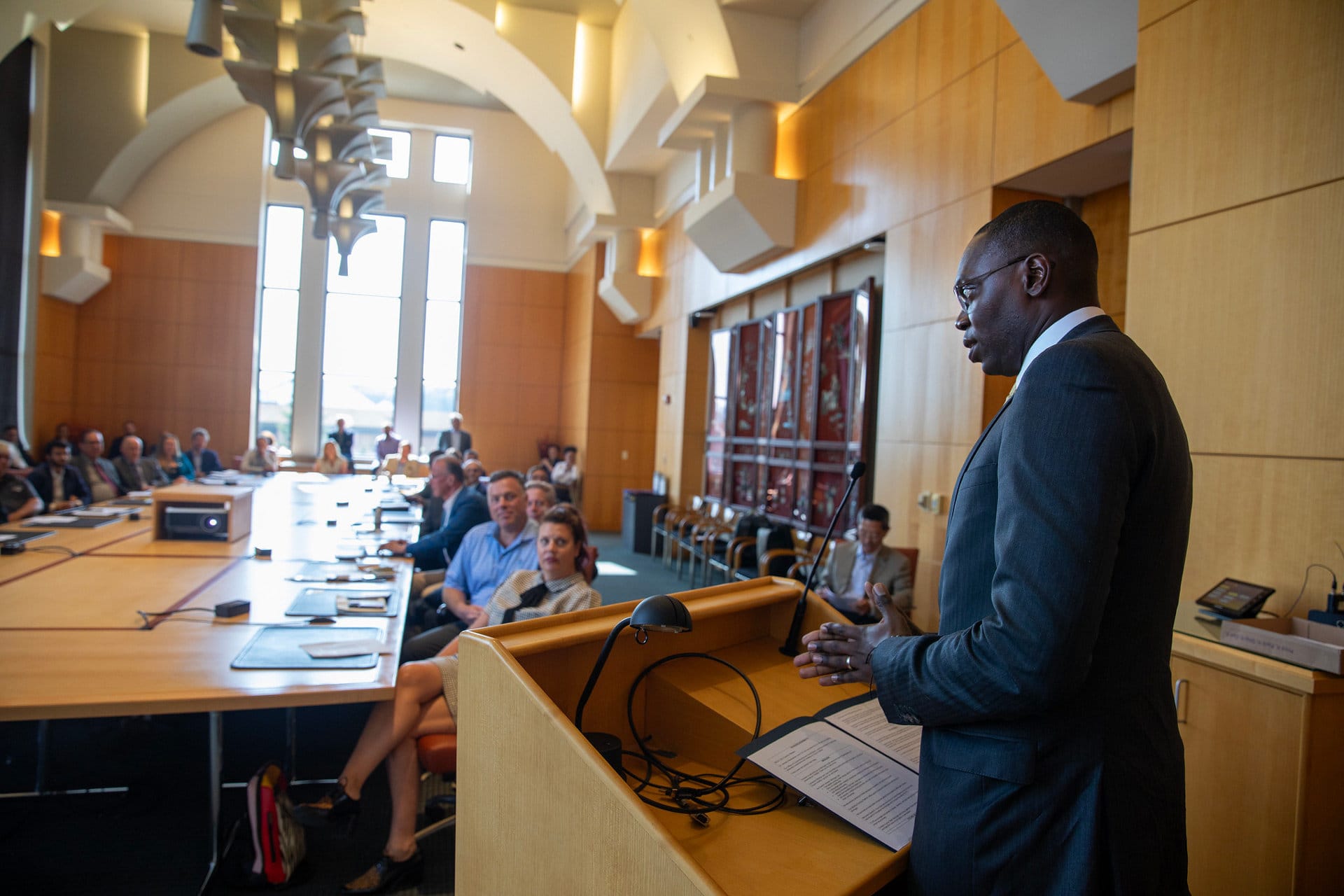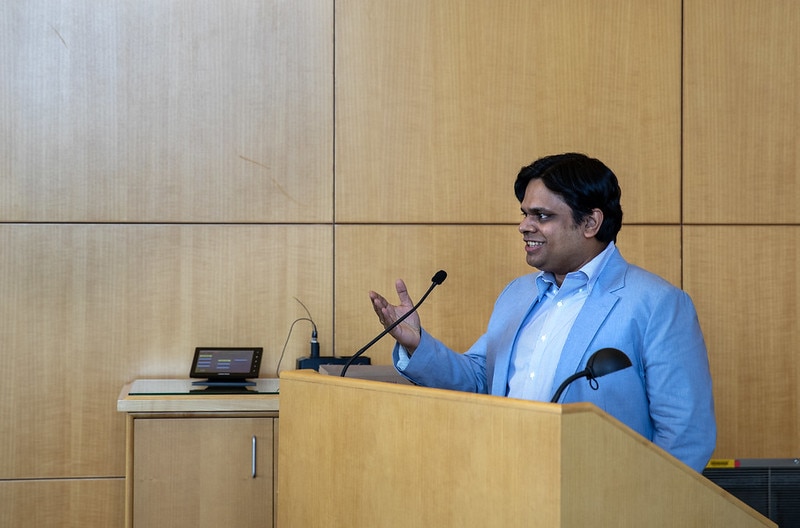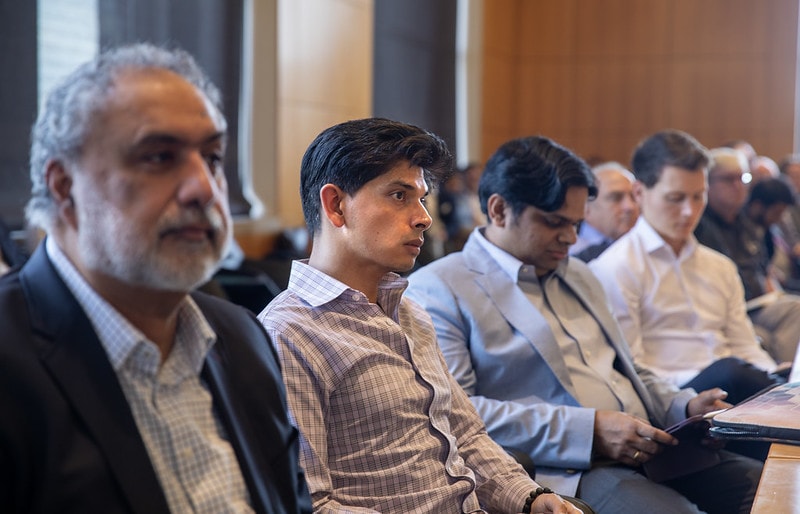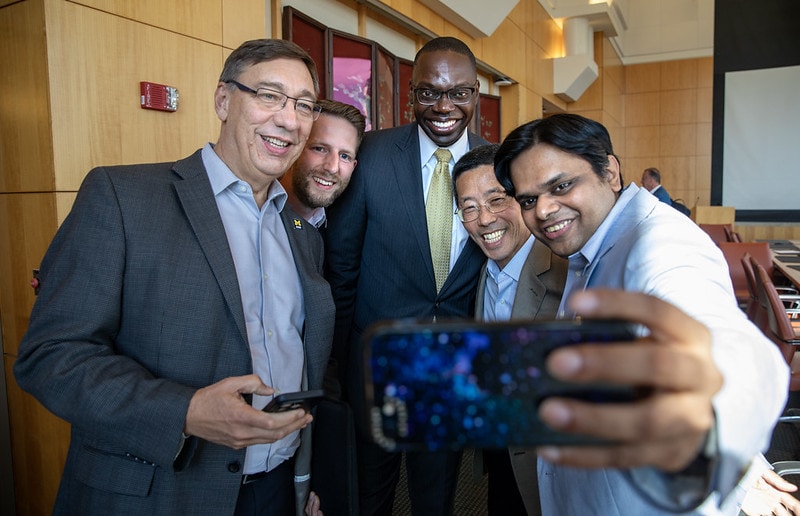
Electric aviation: Battery experts, aero entrepreneurs, state leaders and venture capitalists converge
‘Here, we have industry and expertise. Take that and combine it with belief—and magic happens.’

‘Here, we have industry and expertise. Take that and combine it with belief—and magic happens.’
Roughly 40 decision-makers in battery research, industry, aviation and government met at Michigan Engineering on Aug. 3 to talk about electrifying aviation as the nation’s first battery research program housed in a top aerospace department begins to take shape.
The event was organized by Venkat Viswanathan, an incoming professor of aerospace engineering who specializes in high-energy density batteries for aviation. His research program at the University of Michigan will begin this fall. What started as an academic housewarming of sorts grew as attendees recognized the rare opportunity to meet across disciplines to talk about an emerging technology that could take off over the next decade—the way electric cars have in the previous.

“The e-mobility revolution presents an opportunity for all of us to lead the world toward a more sustainable future. And, at Michigan, this means land, sea, space, and air mobility,” said Steve Ceccio, U-M dean of engineering.
The College of Engineering recently launched a new $130 million Electric Vehicle Center. Meanwhile, the Department of Aerospace Engineering has long been a leader in electric propulsion for space, and the Department of Naval Architecture and Marine Engineering is advancing electric shipping. Viswanathan’s research program will begin to address electric mobility in air.
A thread through the conversation was an energy density goal of 1 kilowatt-hour per kilogram, more than three times the energy density of the batteries that power electric vehicles today.
“I’m grateful to the electric aviation field for setting that target for us. Energy density for cars is getting a bit boring,” said Yet-Ming Chiang, the Kyocera Professor of Ceramics at the Massachusetts Institute of Technology, to laughter from the crowd. Chiang is known for his research and entrepreneurship in advanced batteries.
In battery research, the energy density problem is considered essentially solved for electric cars. Today’s electric cars average a range of 290 miles, with 8- to 10-year warranties. Airplanes, on the other hand, need much higher energy density to be practical for cross-country flights.
Speaking to the crowd, Michigan Lieutenant Governor Garlin Gilchrist II and Quentin Messer, Jr., chief executive & economic competitiveness officer of the Michigan Economic Development Corporation, made a pitch for the state of Michigan as a place for testing new technologies and building electric aviation companies.

In particular, Gilchrist touted the Ford Launchpad for Innovative Technologies and Entrepreneurship, which runs out of the Gerald R. Ford International Airport in Grand Rapids. It provides access to test out new and emerging technologies in aviation in a working airport environment. He also promised a “thicker pipeline” of engineering and technical problem-solving professionals “than any other state in the country.”
“The State of Michigan is going to be a partner, coconspirator and coinvestor in these efforts,” he said.
Speaking on behalf of the Department of Energy, Paul Dearhouse opened with a greeting in Ojibwe/Anishinaabe, welcoming the gathering to one of his ancestral homelands. Then he invited electric aviation entrepreneurs to apply for some of the $400 billion that the federal government is investing in clean energy technologies.
While “the U.S. is comfortable innovating,” Dearhouse said, “it may have a bit of muscle atrophy” in manufacturing, and this is part of what the program is trying to address. It provides a “bridge to bankability” for early-stage technologies, he said, enabling companies to prove out technologies so that more conservative capital can see value that outweighs risk.
Carlos Cesnik, the Richard A. Auhll Department Chair of Aerospace Engineering, discussed the Michigan Institute for Sustainable Aviation, which launched earlier this year. The institute brings together expertise across the department, tackling the problem from many angles. Beyond building better airplanes, the institute will explore how to optimize air traffic control and electric airline operations, as well as the environmental, economic and social impacts of aviation.

Viswanathan says he chose to come to Michigan from Carnegie Mellon University because of the “incredible battery ecosystem in the Detroit area” including Our Next Energy, paired with the U-M Aerospace Engineering Department’s ambitions for the future of aerospace.
He believes batteries for aviation are approaching a “Bannister moment,” referring to Roger Bannister, the first man on record to run a mile in less than four minutes. “Doctors said it was impossible—that his lungs would explode,” said Viswanathan.
But once Bannister decided to attempt it anyway, Viswanathan said, “It’s not shocking that he did it. It’s shocking how long that record stood: 46 days.”
Once breaking the limit was shown to be possible, athletes pushed further, and this is what Viswanathan anticipates for battery technology.
Like Chiang, the attendees were broadly supportive of the “Batt 1K” target.
“Most people are only shooting for 400 to 500 Watt hours per kilogram. An ambitious number like 1k is needed,” said Rajesh Swaminathan, a partner at Khosla Ventures. Khosla is invested in batteries, including the company QuantumScape, as well as aviation. It is exploring emerging electric aviation companies.

Geoff Bower, chief engineer at Archer Aviation, said that battery technology is already to the point that it is feasible to offer electric taxi services running from airports to city centers. This is what Archer is doing in New York City, collaborating with United to launch a service running between Newark Liberty International Airport and downtown Manhattan with 10-minute journey times.
“Any improvements will be very beneficial for business in the future,” said Bower. “I’m excited to see Venkat working on these problems.”
Mohit Singh, chief development officer at QuantumScape, said there were no clear paths to the 1k goal. His company produces lithium metal batteries for electric vehicles, with Volkswagen among its customers. While lithium metal chemistries provide a boost over the lithium ion batteries in most consumer electronics, he says a new chemistry will be needed to hit a thousand watt hours per kilogram.
“You have to keep it out there,” Singh said. “It enables people to dream, to think outside the box.”
Dipender Saluja, managing partner at Capricorn Investment, says his firm is getting in early with electric aviation, as they did with Tesla. Capricorn is invested in Joby Aviation as well as QuantumScape.
“Here, we have industry and expertise,” Saluja said. “Take that and combine it with belief, and magic happens.”
Chiang is also a professor of materials science and engineering at MIT. Cesnik is also the Clarence L (Kelly) Johnson Collegiate Professor of Aerospace Engineering at U-M. Ceccio is also the Vincent T. and Gloria M. Gorguze Professor of Engineering, a professor of naval architecture and marine engineering, and professor of mechanical engineering and applied mechanics.